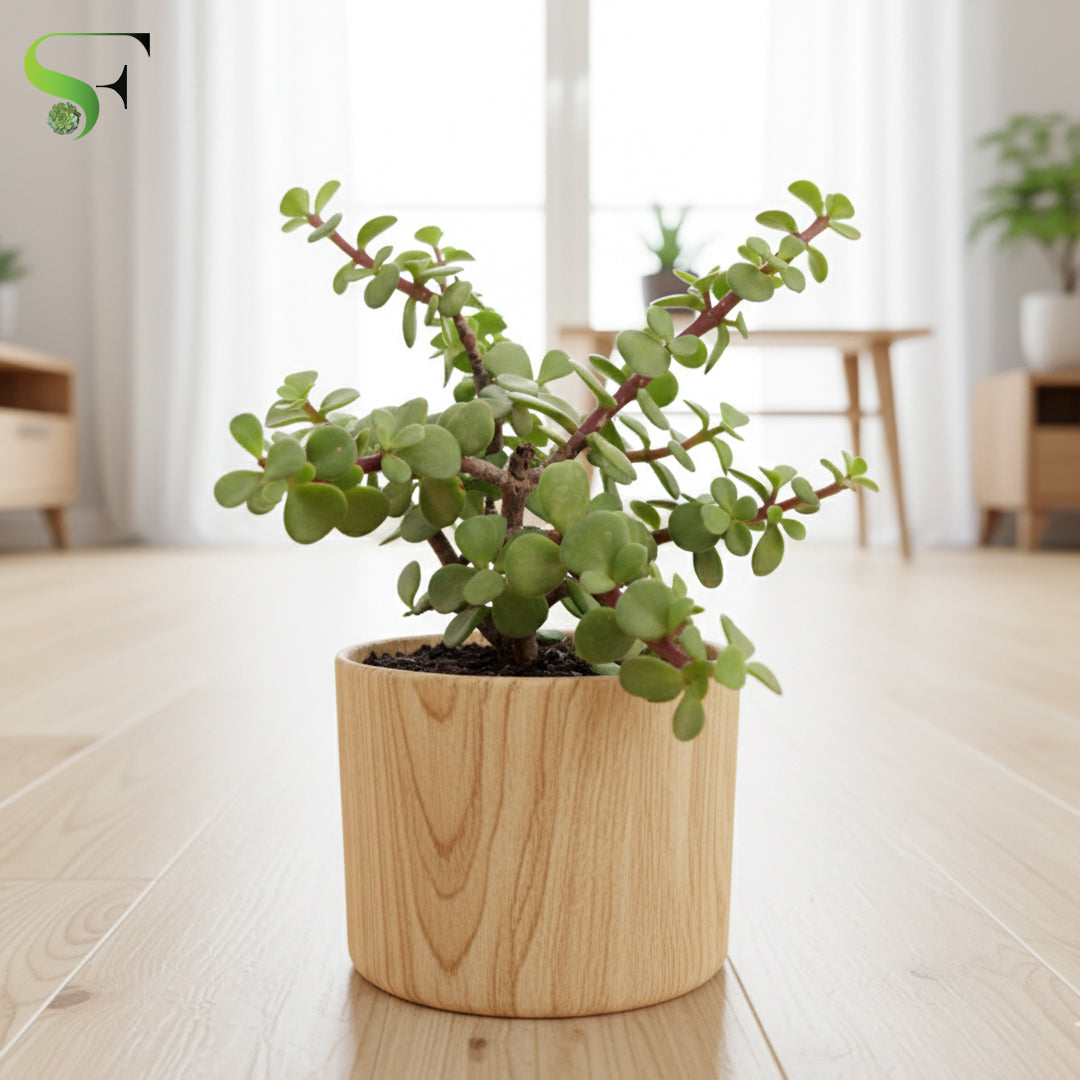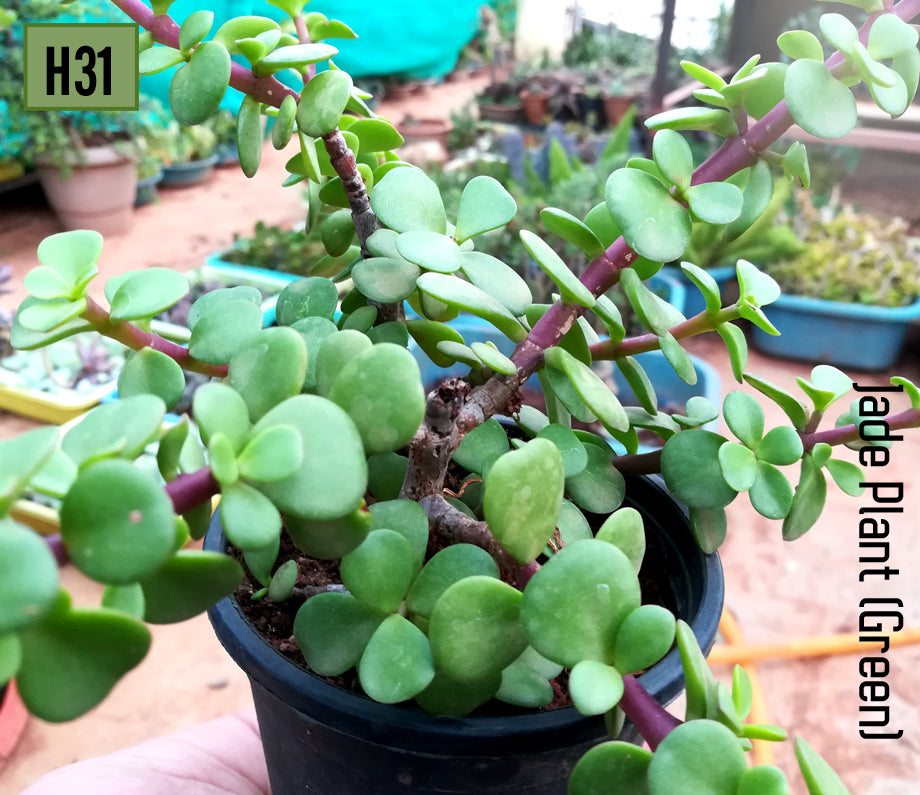Elephant Bush Jade
Elephant Bush Jade
Couldn't load pickup availability
ALL THE PLANTS WILL BE SENT BAREROOTED. NO POTS. NO SOIL
Portulacaria afra, widely known as Elephant Bush, Dwarf Jade, or Spekboom, is a remarkable and versatile succulent native to South Africa. Often mistaken for the common Jade Plant (Crassula ovata), the Elephant Bush is distinguished by its smaller, rounder leaves and more rapid, sprawling growth. This hardy and attractive plant is perfect for a variety of uses, from a low-maintenance houseplant to a striking bonsai specimen or a drought-tolerant outdoor shrub in warm climates.
Detailed Description
Portulacaria afra is a semi-evergreen, soft-wooded, and semi-woody succulent shrub. In its native habitat, it can grow into a large, upright bush or small tree reaching up to 15 feet tall. However, when grown in containers, it typically remains a much more manageable size, around 2-3 feet tall, with a bushy and trailing habit.
Its most notable features are the thick, reddish-brown stems and the small, glossy, round, fleshy leaves that are a vibrant green. There are also popular variegated cultivars with creamy-white or yellow edges. This plant is a crucial food source for elephants and other wildlife in its native range, which is how it earned its common name. While it can produce small, pink or white, star-shaped flowers at the tips of its branches, blooms are rare in cultivation, especially when grown indoors.
Growing Tips
The Elephant Bush is an excellent plant for beginners due to its low-maintenance nature and ability to withstand some neglect.
-
Sunlight: This succulent thrives in bright, indirect light to full sun. Indoors, a south or west-facing window is an excellent location. If grown outdoors, it loves sunlight but may benefit from some afternoon shade to prevent leaf scorching in very hot climates. Insufficient light can lead to a leggy plant with sparse, stretched-out stems.
-
Fertilizing: The Elephant Bush is not a heavy feeder. During its active growing season in spring and summer, you can apply a diluted, balanced succulent or cactus fertilizer once a month. Avoid fertilizing in the fall and winter.
-
Pruning: Regular pruning is beneficial to maintain a compact, bushy shape and can be done at any time. The plant responds well to pruning, making it a popular choice for bonsai enthusiasts.
Temperature and Hardiness
Portulacaria afra is a heat-loving plant that does not tolerate frost.
-
Temperature: It thrives in a temperature range of 65°F to 80°F (18°C to 27°C). It can survive temperatures as low as 30°F (-1°C) for short periods, but it is best to protect it from freezing conditions.
-
Hardiness Zones: It is hardy in USDA zones 9-11. In colder climates, it is best grown as a houseplant and moved outdoors during the warm summer months.
Water Requirements
Overwatering is the most common cause of problems with Elephant Bush. Like other succulents, it stores water in its leaves and stems and is highly drought-tolerant.
-
Watering Frequency: Use the "soak and dry" method. Allow the soil to dry out completely between waterings. The leaves will begin to shrivel slightly when the plant is thirsty. Water deeply and thoroughly, allowing all excess water to drain from the pot.
-
Seasonal Changes: Reduce watering significantly in the cooler, less active months of fall and winter.
Soil Preparation
Properly draining soil is the single most critical factor for the health of your Elephant Bush to prevent root rot.
-
Ideal Mix: A commercial succulent or cactus potting mix is a perfect choice.
-
DIY Mix: You can create your own by blending regular potting soil with gritty materials like perlite, coarse sand, or pumice to improve drainage. A mix with at least 50% inorganic material is ideal.
-
Potting: Always use a pot with a drainage hole. Terracotta or clay pots are an excellent choice as their porous nature helps to wick away excess moisture.
Propagation
Propagating the Elephant Bush is incredibly easy, with a very high success rate.
-
Stem Cuttings: This is the most common and simple method.
-
Using a clean, sharp knife or pair of clippers, take a healthy stem cutting that is a few inches long.
-
Allow the cutting to "callous over" or dry out for a few days to a week. This step is crucial as it prevents the cut end from rotting.
-
Once the end is dry, plant the cutting in a pot with well-draining succulent soil.
-
Water sparingly until the new plant has established roots, which typically happens within a few weeks.
-
-
Leaf Cuttings: You can also propagate from individual leaves, although it is less common. Gently remove a healthy leaf, allow it to callous over, and then lay it on top of or slightly pressed into the soil.
#ElephantBush #PortulacariaAfra #Succulent #DwarfJade #Houseplant #Bonsai #DroughtTolerant #GardeningTips #PlantPropagation #LowMaintenance
Share




